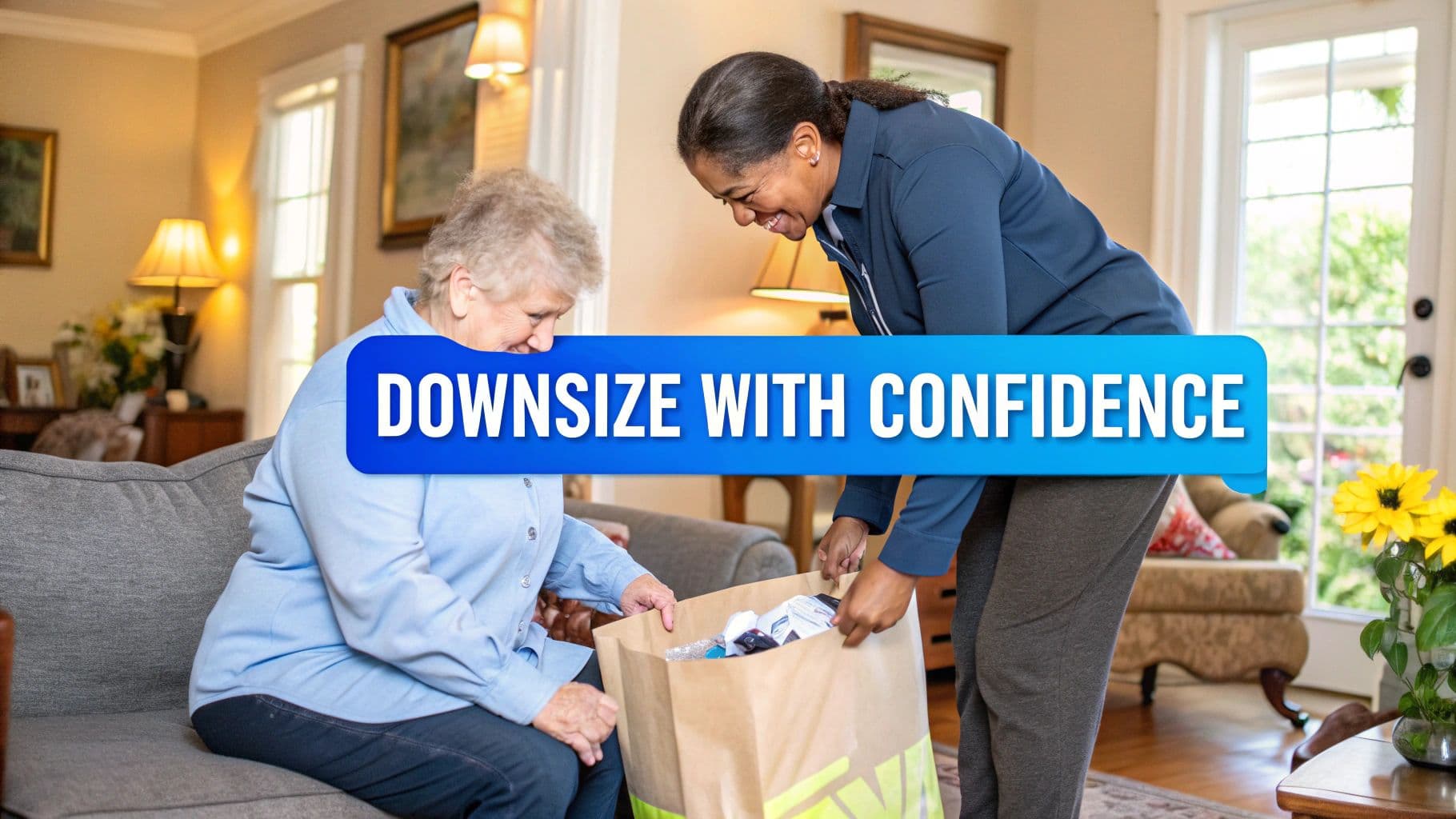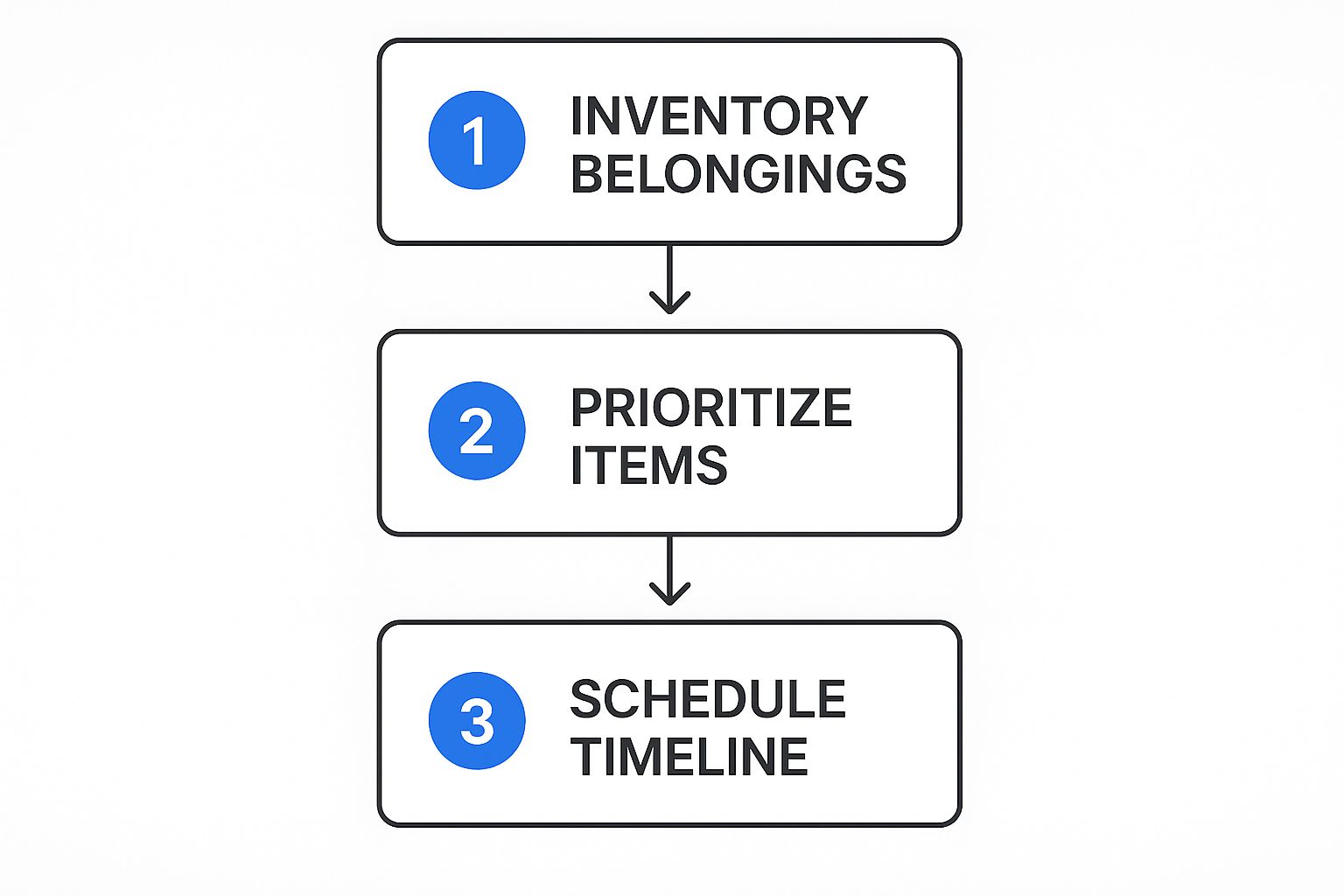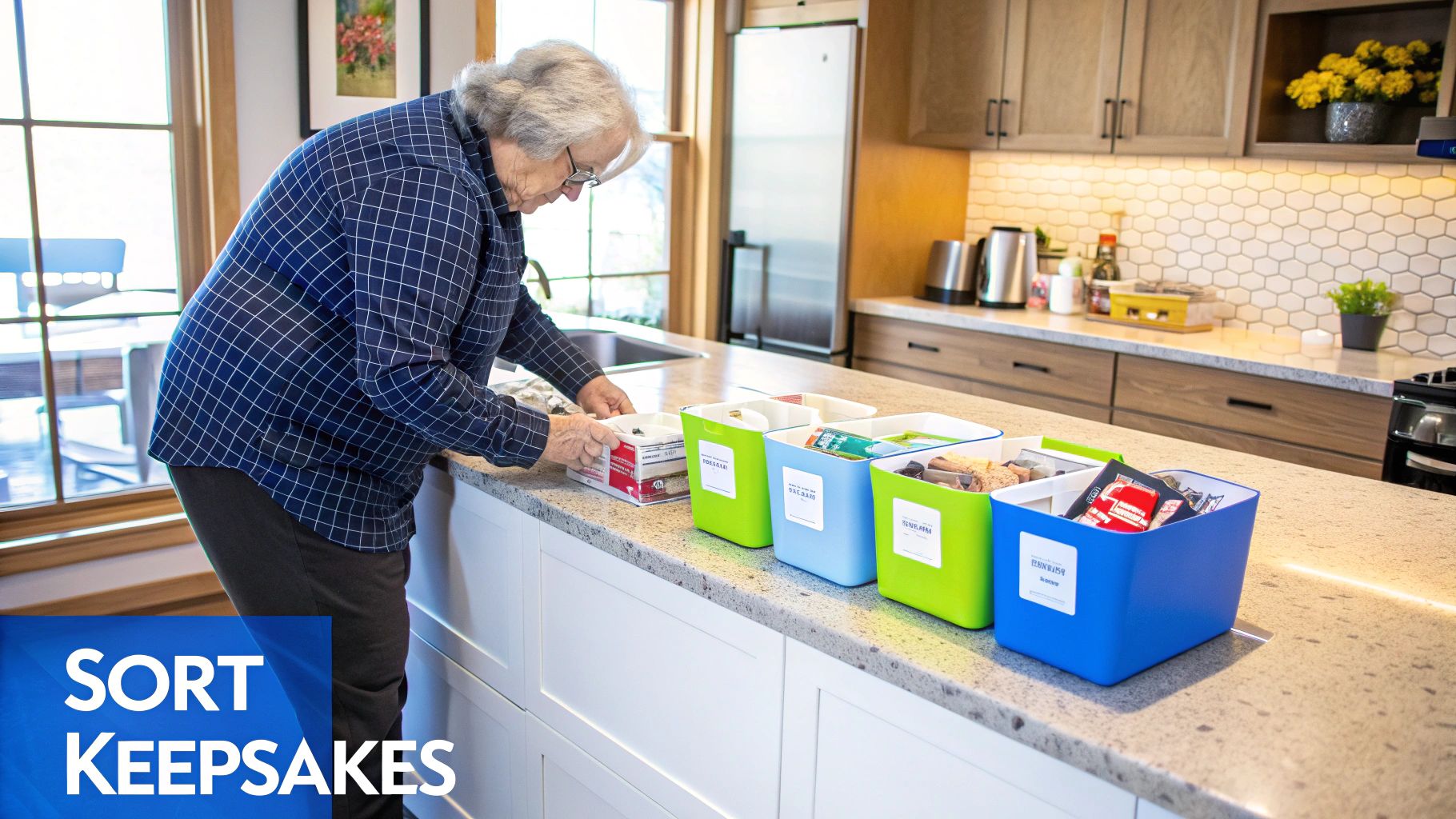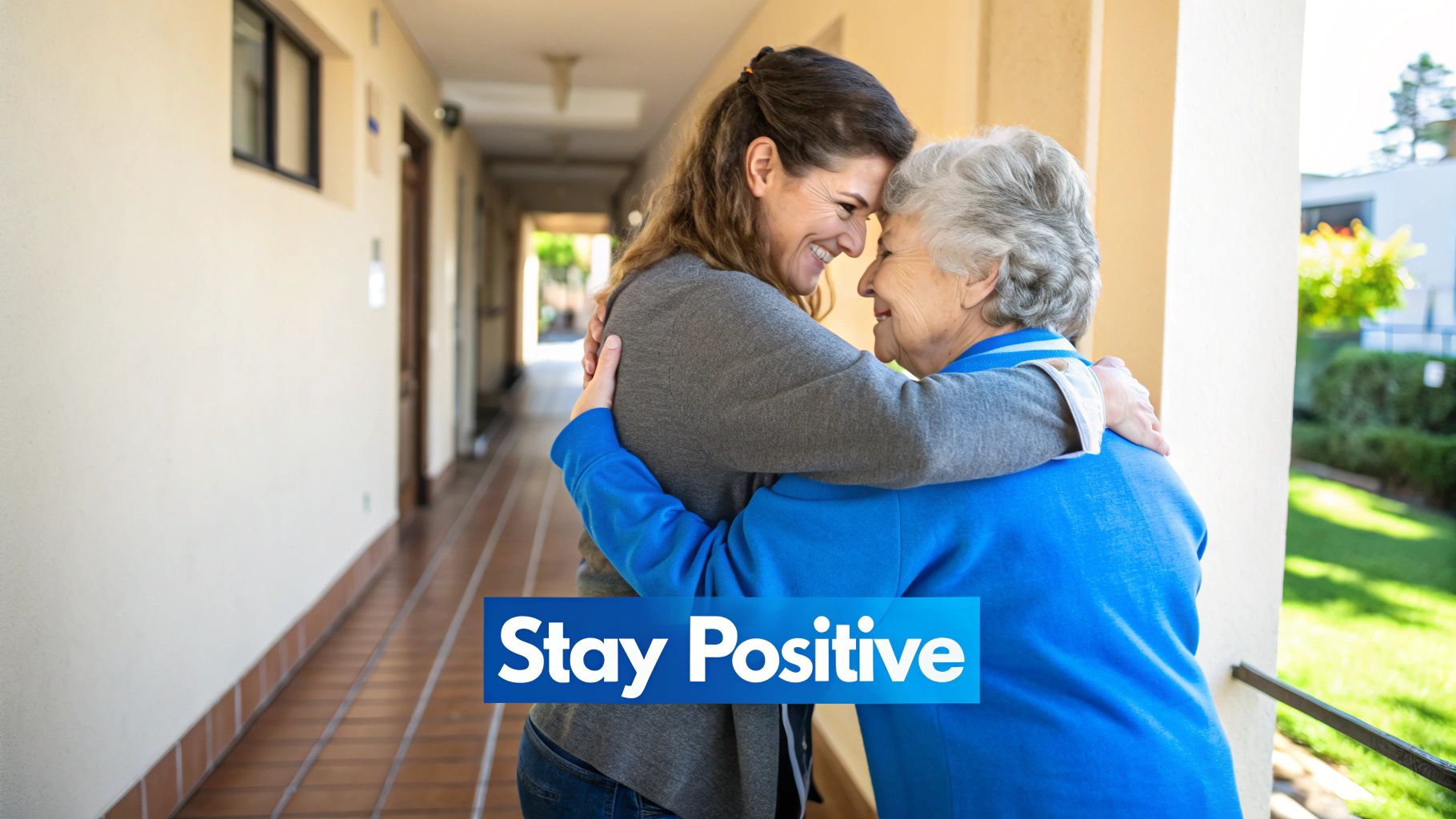A Guide to Helping Seniors Downsize with Confidence

Before you even think about boxes and bubble wrap, the downsizing journey with a senior parent or loved one starts with a conversation. And not just any conversation—it has to be one built on compassion, not a to-do list.
The most successful transitions happen when you frame it as a collaborative plan for a simpler, safer future, rather than an urgent demand. It all begins by listening to their feelings and honoring the lifetime of memories tied to their home.
Starting the Downsizing Conversation with Empathy

For many older adults, their home isn't just a building. It's a living archive of family holidays, scraped knees, and decades of personal history. So when you bring up the idea of leaving, it can feel like you're asking them to abandon a part of themselves.
This is exactly why that first chat must be handled with incredible care. Any hint of pressure or an ultimatum will likely be met with resistance, and for good reason. Your goal is to build a partnership, not issue a directive. Your role is to listen, support, and gently guide—long before a move becomes absolutely necessary.
Finding the Right Time and Tone
As with any delicate topic, timing is everything. It's far better to find a natural opening than to force the issue. A perfect moment might be after they mention that the yard work is getting to be too much, or maybe after a close friend has a positive experience moving into a more manageable home.
When you do talk, keep your tone gentle and exploratory. Use words like "we" and "us" to show this is a team effort, a shared journey you'll navigate together. Steer clear of any language that sounds critical, like pointing out clutter or deferred maintenance.
Instead, keep the focus on the positive outcomes.
- Highlight the Benefits: Talk about the freedom from endless house repairs, the relief of lower utility bills, or the simple joy of being closer to grandchildren.
- Plant Seeds: Ditch the idea of a single, monumental "talk." Opt for several small, low-pressure chats over weeks or even months.
- Ask Open-Ended Questions: Gently encourage them to share their own thoughts. Try something like, "Have you ever thought about what life might be like with less to worry about around the house?"
The key is to shift the narrative from one of loss to one of opportunity. Downsizing isn't about giving things up; it's about gaining time, freedom, and peace of mind for their next chapter.
Acknowledging Their Fears and Feelings
Often, any resistance to downsizing comes from a place of fear. It could be the fear of losing their independence, cherished memories, or their connection to a beloved community. It's absolutely crucial to acknowledge these feelings without trying to dismiss them.
For instance, if they say, "I can't leave this house; it's where we raised you," a validating response is, "I know. This house holds so many wonderful memories for all of us." That simple sentence shows you hear them and understand the emotional weight of the decision.
Simple Ways to Start the Conversation
Getting the ball rolling is often the hardest part. Generic questions can fall flat, so try framing them around their well-being and future happiness. Here are a few ideas that have worked for others:
- "I was thinking about the future and just wanted to make sure we’re all prepared. What are your thoughts on where you’d like to be in five or ten years?"
- "This house has been so wonderful for so long, but I sometimes worry about you managing the stairs/yard/repairs. Have you ever considered options that might be a little easier?"
- "Let's dream a little. If you didn't have this big house to take care of, what would you do with your extra time and money?"
These kinds of openers position you as a caring partner, not a problem-solver. By leading with empathy, you build a foundation of trust that will make the entire downsizing process smoother and more respectful for everyone involved.
Building a Practical and Stress-Free Downsizing Plan
Once you've had those initial, important conversations, it’s time to move from the abstract idea of downsizing to a concrete, workable plan. A solid roadmap is what keeps the process from spiraling into chaos. It gives your loved one a real sense of control, turning what feels like a monumental task into a series of small, achievable wins.
The best place to start? The destination. Before you even think about sorting a single shoebox, get the exact dimensions and a floor plan of the new living space. Measure every room, note the closet sizes, and start mapping out where essential furniture could go. This simple, practical step grounds every decision you'll make, changing the question from a vague "What should we keep?" to a much clearer "What will comfortably and safely fit?"
Creating a Realistic Timeline
Probably the biggest mistake families make is trying to rush the process. Downsizing a lifetime of memories isn't a weekend job—it's a marathon, not a sprint. A hurried timeline just creates needless stress and often leads to decisions people later regret. You need to build a schedule that allows for patience, reflection, and plenty of breaks.
Think of it in manageable phases:
- Quick Wins (1-2 Weeks): Start with the easy stuff. Tackle areas with low emotional attachment, like the linen closet, laundry room, or that infamous junk drawer. These small victories are great for building momentum.
- The Core Sort (4-8 Weeks): Now you can move on to the bigger rooms—bedrooms, the kitchen, the home office. But don't try to conquer a whole room in a day. Focus on one small section at a time, like a single bookshelf or one side of the closet.
- Sentimental Items (2-3 Weeks): This is the tough part. Set aside specific, dedicated time for photos, heirlooms, and personal collections. This phase requires the most empathy and patience from everyone involved.
- Logistics and Packing (2 Weeks): After the decisions are made, you can finally focus on the action: selling, donating, and packing the items that are making the move.
This infographic lays out the basic flow from big-picture thinking to getting things done.

As you can see, a successful plan moves from a broad assessment to specific actions. This logical order is your best defense against feeling overwhelmed.
Budgeting for the Move
Downsizing isn't just an emotional effort; there are real financial costs to consider. Sketching out a simple budget early on will prevent any nasty surprises down the road.
Be sure to account for these common expenses:
- Movers: Get quotes from at least three reputable moving companies. You'd be surprised how much the prices can vary.
- Packing Supplies: The cost of boxes, tape, and packing paper adds up quickly. Pro tip: check local community forums or marketplace sites for free or cheap used boxes.
- Storage Units: Sometimes you need a temporary holding space for items you're not ready to part with.
- Junk Removal: For anything that can't be sold or donated, you might need to hire a service to haul it away.
As you map things out, thinking about practical storage solutions for moving home can be a real game-changer. It buys you time, letting you make more thoughtful decisions without the pressure of a looming move-in date.
Comparing Downsizing Support Options
You don't have to do it all alone. A variety of professionals can step in to ease the burden, each offering a different level of service. Understanding what's available helps you decide where you might need the most help.
| Service Type | Key Responsibilities | Estimated Cost Range | Best For |
|---|---|---|---|
| Senior Move Manager | Oversees the entire process: planning, sorting, packing, coordinating movers, unpacking. | $1,500 - $5,000+ | Families needing comprehensive, hands-on support from start to finish, especially if they live far away. |
| Professional Organizer | Focuses specifically on decluttering, sorting, and creating organizational systems. | $50 - $150 per hour | People who can manage the move logistics but need expert help with the decision-making and sorting phases. |
| Junk Removal Service | Hauls away unwanted items, furniture, and trash that cannot be sold or donated. | $200 - $800 per truckload | Efficiently clearing out a large volume of non-sellable items after the sorting process is complete. |
| Estate Sale Company | Manages the sale of household contents, either in-person or online. Handles pricing. | 30% - 50% commission on sales | Individuals with a significant number of valuable items to sell who prefer to outsource the entire sale. |
| Moving Company | Physically transports packed boxes and furniture from the old home to the new one. | $800 - $3,000+ (local move) | The essential final step for the physical relocation of belongings once everything is packed and ready to go. |
Choosing the right help depends entirely on your family's budget, timeline, and where you feel you need the most support.
Assigning Roles and Responsibilities
A clear plan also answers the question: "Who's doing what?" One person trying to manage everything is a surefire recipe for burnout, and undefined roles can quickly lead to family arguments. Have an honest conversation about who can help, how they can help, and when they're available.
A collaborative plan is essential. Dividing tasks ensures no single person is shouldering the entire burden, and it reinforces the idea that this is a family effort to support your loved one.
Play to everyone's strengths. Maybe the tech-savvy grandchild is put in charge of photographing items and listing them for sale online. The hyper-organized family member could take the lead on the sorting system and labeling boxes. Even a sibling who lives across the country can pitch in by researching moving companies or handling the utility transfers online. For more checklists and tips, our guide on moving for seniors breaks the process down even further.
By taking the time to map out the timeline, budget, and responsibilities, you're creating the framework for a smooth and successful transition. This plan is truly the best tool you have for helping a senior downsize with dignity and peace of mind.
Sorting Through a Lifetime of Memories

Let's be honest: this is the hardest part. You’re not just sorting through stuff; you’re handling a lifetime of memories, milestones, and personal history. This step requires an incredible amount of patience and empathy.
The key is to change the narrative from "getting rid of things" to "honoring a legacy." Every single item has a story, and rushing the process can feel like you're dismissing their life's most important moments. It’s about respecting the emotional weight of their belongings while gently guiding them toward the practical goal of a new, more manageable home.
Start Small to Win Big
Diving headfirst into the most cluttered room is a surefire way to feel overwhelmed and quit. Instead, I always recommend the 'One-Room-at-a-Time' method. Better yet, break it down even further: one corner, one closet, or even a single drawer.
This turns a daunting mountain into a series of small, manageable hills. Scoring a quick win in a low-stakes area—like the linen closet or laundry room—builds confidence and momentum. It gets everyone comfortable with making decisions before you have to tackle the really tough, sentimental spaces like the bedroom or office.
A Simple System for Sorting
To keep things from getting chaotic, you need a visual system. I’ve found that using colored tarps, different bins, or even big sticky notes works wonders. Create a clear spot for each category.
- Keep: These are the non-negotiables. The things that are absolutely making the move to the new home.
- Donate: Items in good, usable condition that someone else can get value from.
- Sell: Possessions with real monetary value that you could sell at an estate sale, on consignment, or online.
- Family/Gift: Belongings that have already been promised to family members or friends.
- Undecided: A temporary holding pen for things that are tough to decide on. Just don't let this pile get too big! It’s okay to revisit it at the end of the day.
The goal here is progress, not perfection. If a decision on one item is stalling everything, put it in the 'Undecided' pile for a bit and keep moving. Getting stuck can derail an entire day's work.
Handling Sentimental Treasures
This is where you need to tread most lightly. These objects are the tangible links to a person's most cherished memories. Dismissing their importance can feel like a personal slight, so a sensitive touch and a few creative solutions are essential.
Think about it: the demand for senior living is so high that for every 10 new units built, 23 are occupied. That’s more than double the supply! Occupancy rates are back up to around 86.5%. This just shows how many families are going through this exact same emotional process right now.
Here are a few strategies that can help preserve the memory without keeping the clutter:
- Create a Memory Box: Designate one or two nice boxes to hold the most precious keepsakes—a child's first drawing, old love letters, special awards. Knowing these treasures are safe and sound in one place makes it easier to let go of other mementos.
- Digitize Photos and Documents: A lifetime of photo albums takes up a ton of space. Scanning old photos and important papers creates a digital archive that you can easily share with the whole family.
- Repurpose Heirlooms: Can a piece of Grandma’s wedding lace be framed? Can a single, beautiful teacup from a huge set become a pencil holder? Finding a new purpose for an old item gives it new life.
Tackling Duplicates and Collections
Over decades, it’s only natural to end up with multiples of things—three sets of holiday dishes, five non-stick pans, a dozen extra blankets. The logic here is simple: keep the best one, and let the rest go.
The same idea applies to collections. A lifetime of collecting stamps or figurines brought years of joy, but moving the entire set might not be practical. Encourage your loved one to pick a few absolute favorites to display in their new space. The rest can be passed down to another family member or sold to a fellow collector. Our guide offers more specific advice to help with decluttering, especially when you're dealing with a large volume of similar items.
Throughout all of this, your most important job is to be a supportive listener and a gentle guide. Celebrate every small decision and every box filled for donation. When you treat this process like a meaningful journey of remembrance, you help your loved one honor their past while embracing a simpler, more comfortable future.
You’ve sorted through everything, and now you’re standing in front of several distinct piles. The hard emotional work is done. Now, it's time to handle the logistics and find a new home for everything that isn’t coming with you.
This is the phase where decisions turn into actions. The goal is simple: handle each category of items with care and efficiency, making sure valuables are respected and usable goods find a new purpose. It’s all about honoring the past while making way for a simpler, less cluttered future.
Maximizing Value Through Selling
For items that still have some monetary value, you’ve got a few solid options. The best path forward really depends on what you’re selling, its condition, and how much time and effort you want to put into the process.
- Estate Sale Companies: This is the most hands-off approach. These pros come in and manage the entire sale, from pricing and staging to advertising and managing the event. They typically take a commission of 30% to 50%, but for a house full of quality antiques, furniture, and collectibles, it can be well worth it.
- Consignment Shops: Have some high-end furniture, designer clothing, or unique décor? A consignment shop might be a perfect fit. They’ll sell the item for you and take a cut, but it saves you the hassle of finding a buyer yourself.
- Online Marketplaces: If you're comfortable with a more DIY approach, platforms like Facebook Marketplace or eBay let you sell directly to buyers. This method requires more work—taking good photos, writing descriptions, and coordinating with people for pickup—but you keep all the profit.
For a modern, streamlined approach that combines control with broad reach, an online estate sale is a fantastic alternative. If you're looking for pointers on this, our article on how to sell furniture when moving is packed with practical tips that are just as useful here.
Donating with Purpose
Donating items is a wonderful way to give them a second life and support a cause you care about. But a little planning goes a long way to ensure your donations can actually be used.
Before you start loading up the car, always check the charity’s donation guidelines. A quick look at their website or a phone call can tell you what they need and, more importantly, what they can't accept. Most organizations, for example, cannot take old mattresses, CRT televisions, or large appliances.
A quick check saves you from a wasted trip. Plus, some charities like Habitat for Humanity ReStore or the Salvation Army offer pickup services for large furniture donations, which is a massive help when you're coordinating a downsize.
Preparing for the Actual Move
With the "sell" and "donate" piles cleared out, you can finally focus on what’s making the move. Good packing is so much more than just tossing things in boxes. It’s about protecting cherished items and setting the stage for a smooth, comfortable first few days in the new home.
This is more important than ever, as the global senior living market is expanding rapidly. It's projected to grow by about USD 130.9 billion in the next few years, largely thanks to the aging baby boomer population. This trend means more specialized housing options are becoming available, making a well-organized, stress-free move the best way to start this new chapter. You can discover more insights about these market trends on PR Newswire.
Strategic Packing for a Smooth Transition
A smart packing strategy is your best friend on moving day. It prevents breakage, cuts down on stress, and helps your loved one feel settled in their new space much faster.
-
Pack an "Essentials" Box. This is, without a doubt, the most important box you will pack. It should hold everything needed for the first 24 to 48 hours: medications, toiletries, a change of clothes, phone chargers, important papers (like the moving contract), and maybe even a coffee maker and some snacks. Keep this box with you—do not let it go on the moving truck.
-
Protect Fragile Items. Be generous with packing paper, bubble wrap, or even soft household linens like towels and blankets to cushion anything breakable. Clearly mark these boxes "FRAGILE" on every single side so the movers know to be extra careful.
-
Label Everything Clearly. Don’t just write "Kitchen." Get specific. "Kitchen - Everyday Dishes" or "Bedroom - Linens." This little bit of extra detail turns unpacking from a chaotic guessing game into a straightforward, manageable task. For bonus points, number each box and keep a simple inventory list on your phone or in a notebook.
What about those items that won’t fit in the new place but are too sentimental to part with? Or things you might need later on? You can always explore various storage solutions. A small, climate-controlled unit can be the perfect temporary home for these belongings, giving you time to make final decisions without cluttering up the new space.
Making the New Space Feel Like Home

The moving truck has pulled away and the last box is inside. It might feel like the finish line, but this final stretch is arguably the most crucial. The real work now is transforming an unfamiliar set of rooms into a genuine home—a place of comfort, safety, and belonging.
This isn’t just about unpacking. It's an emotional process of putting down new roots. The goal is to make the new environment feel personal and familiar as quickly as possible, helping your loved one feel settled, not displaced. A little thoughtfulness here goes a very long way.
Prioritizing Comfort and Familiarity
Start by recreating the feeling of their old home, just on a smaller scale. If you took photos of how key furniture was arranged before the move, now’s the time to pull them out.
Try to place their favorite armchair in a similar spot, complete with its reading lamp and side table. Unpack the box of family photos first and get them onto a mantle or bookshelf. These small visual cues are incredibly powerful, creating an immediate sense of continuity and comfort.
- Set up the bedroom first. A familiar, comfortable sleeping space is non-negotiable. A good night's rest is critical for lowering stress during the transition.
- Arrange the living area next. Focus on creating a cozy, functional space with their most-used items, like their go-to chair and the television remote.
- Then, tackle the kitchen. Just unpacking the coffee maker and a few essentials for a simple meal can restore a huge sense of normalcy right away.
Designing for Safety and Accessibility
One of the biggest upsides of downsizing is the opportunity to create a safer, more manageable living environment. As you unpack and arrange the furniture, keep accessibility front and center in your mind.
Clear, wide pathways are a must. Make sure there’s plenty of room to move between furniture, especially if they use a walker or cane. Ditch any tripping hazards like loose rugs, and make sure electrical cords are tucked away safely out of traffic paths.
A critical part of this process is ensuring their new home truly supports their independence. Thoughtful placement of furniture and belongings can significantly reduce the risk of falls, making daily life easier and safer.
This focus on suitable housing is more important than ever. Construction of new senior housing units in the U.S. has hit a major low, falling far short of the estimated 42,000 new units needed each year to meet demand. This supply crunch means we have to be smarter about making any new space as safe and functional as possible. You can learn more about senior living construction trends on cep-dc.org.
Encouraging New Routines and Connections
Helping a loved one settle in goes beyond the four walls of their new home. The social and emotional adjustment is just as important as the physical one.
Gently encourage them to build new daily routines that bring a sense of purpose. If they always enjoyed a morning walk, help them map out a safe and pleasant new route. If they loved to garden, maybe a few potted plants on a balcony or windowsill can bring that joy into their new space.
Encourage them to meet their new neighbors or explore the community amenities, like a library or social club. This all takes time and patience, so just be there to offer support as they navigate this new chapter and start to feel truly at home again.
Of course. Here is the rewritten section, crafted to sound like it was written by an experienced human expert.
Tackling the Tough Questions About Downsizing
Even with the best-laid plans, helping a senior downsize is an emotional journey filled with unexpected turns. It’s a deeply personal process, and no two families experience it the same way.
Let’s walk through some of the most common challenges you’ll likely face and how to handle them with empathy and respect.
When’s the Right Time to Even Bring It Up?
The best time to start the conversation about downsizing is long before it becomes a necessity. You want to talk about it before a health crisis or other event forces everyone’s hand.
Keep it casual. Maybe a friend of theirs just moved into a more manageable home, or perhaps they mention how tired they are of keeping up with yard work. That's your opening.
Frame it as planning for the future—exploring ways to create a simpler, safer, and more enjoyable lifestyle. It's not about an urgent need to move now. This approach gives them time to get comfortable with the idea and, most importantly, feel like they're in the driver's seat.
What if They Just Don’t Want to Go?
Resistance is completely normal. In fact, you should expect it. It almost always comes from a place of fear—fear of losing cherished memories, their independence, or the life they’ve known.
Your first job is simply to listen. Don't try to counter their feelings with logic. Just acknowledge their concerns and let them know you hear them.
Instead of arguing, try shifting the focus to the positives. Talk about what they’ll gain: no more shoveling snow, more money in the bank, or being just a few minutes away from the grandkids.
Start with a small, manageable task, like cleaning out the medicine cabinet or a linen closet. A small win can build the confidence needed to tackle the garage or the attic. Sometimes, bringing in a neutral third party, like a senior move manager, can work wonders by taking the family drama out of the equation.
"I can't leave this house; it's where we raised you." When you hear this, the best response is one of pure validation: "I know. This house holds so many wonderful memories for all of us." This shows you understand the emotional weight behind their words.
How Can a Smaller Place Ever Feel Like “Home”?
Making a new, smaller space feel like home is all about bringing the feeling with you, not just the stuff. The trick is to prioritize the items that bring joy and serve a real purpose.
Before you move a single box, take photos of how their favorite rooms are set up. You can use these as a guide to recreate that familiar comfort on a smaller scale.
Make sure their favorite reading chair has a prominent spot, the family photos are on the wall, and their most treasured collections are beautifully displayed. Getting them involved in setting up the new place—from picking out paint colors to deciding where the sofa goes—is crucial. It gives them a sense of ownership and helps them bond with the space, turning it from a "new place" into their home.
Are There Professionals Who Can Help With This?
Absolutely. You don't have to do this alone, and you probably shouldn't. There's a whole industry of professionals who specialize in helping seniors downsize and can take a huge weight off your shoulders.
- Senior Move Managers: These are the project managers of the downsizing world. They can handle everything from the initial planning and sorting to packing, moving, and even setting up the new home.
- Professional Organizers: If the sheer volume of stuff is the biggest hurdle, an organizer can help you sort through it all and make those tough keep-or-toss decisions.
- Estate Sale Companies: Have valuable furniture, antiques, or collectibles? These companies can manage the entire process of selling them for you.
When looking for help, do a little research. Check for certifications from organizations like the National Association of Senior & Specialty Move Managers (NASMM) to find pros who are experienced, reputable, and understand the unique emotional needs of this kind of move.